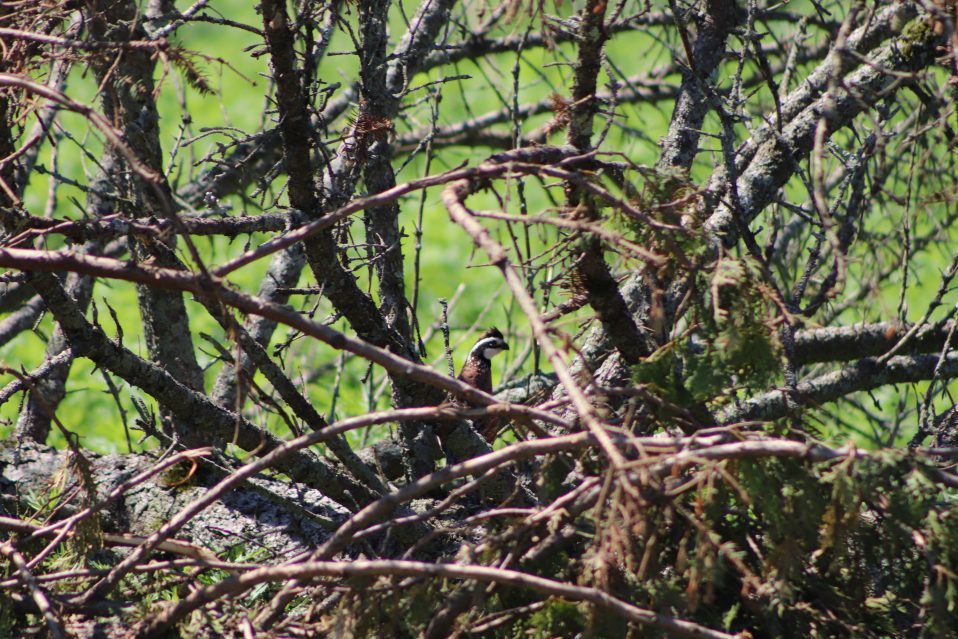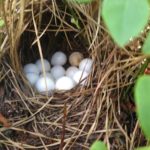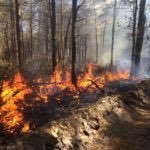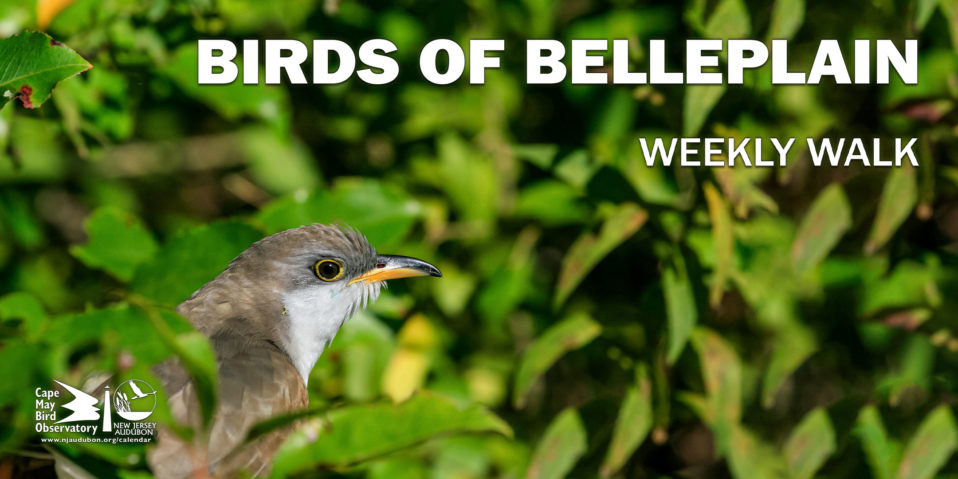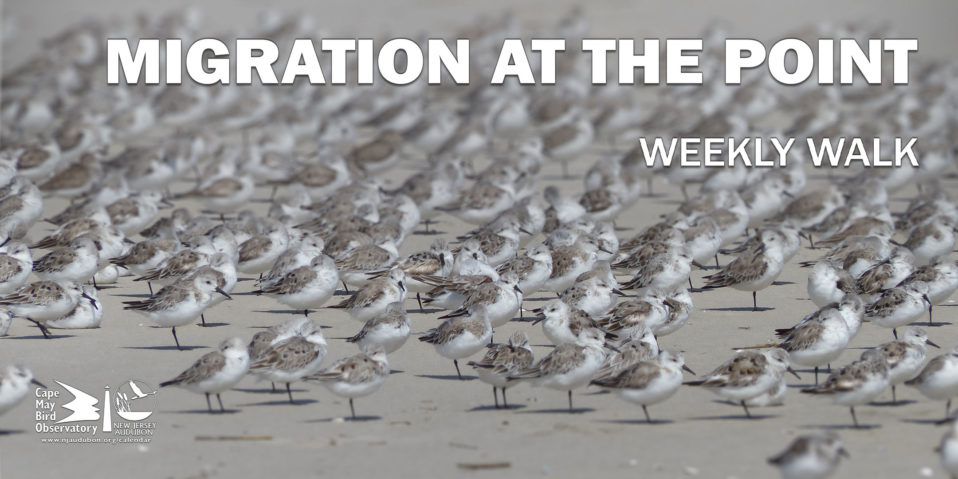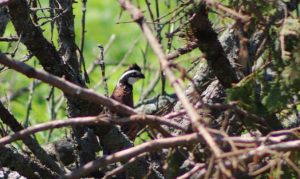
A male Northern Bobwhite Quail in the thickets. Photo by John Parke
Joseph J. White, Inc (which markets through Pine Barrens Native Fruits, LLC), a 390-acre cranberry farm at Whitesbog, NJ that is owned and operated by fifth-generation cranberry growers Joe Darlington and Brenda Conner, recently became the first cranberry producer approved by the United States Department of Agriculture (USDA) to receive federal funding to create habitat for the Northern Bobwhite Quail. The Northern Bobwhite is a non-migratory bird that was once common across its range. However, the Bobwhite has become much rarer today, suffering the most severe population decline of any North American bird (a rate of 85% in the last forty years) according to the North American Breeding Bird Survey.
The project at Pine Barrens Native Fruits arises out of a Farm Bill conservation initiative entitled Working Lands for Wildlife (WLFW) which provides cost share funding for conservation efforts designed to improve agricultural and forest productivity and in turn enhance critical wildlife habitat on these working landscapes. According to the USDA’s Natural Resource Conservation Service (NRCS), which implements WLFW, the focus is on specific declining species (in this case Northern Bobwhite) which can be used as “barometers for success because their habitat needs are representative of healthy, functioning ecosystems where conservation efforts benefit a much broader suite of species.”
A farmer-owner of the Ocean Spray Cranberry, Inc Cooperative, Joseph J White, Inc, working with New Jersey Audubon and NRCS, will be implementing native pollinator plantings, forest stewardship and prescribed burning. This conservation work will not only provide critical habitat needed for a suite of young forest (or early successional) species, some of which are very rare in the New Jersey Pinelands, but will also help to improve forest health, reduce fuel-loads to mitigate the potential for wildfire and improve the health of the watershed.
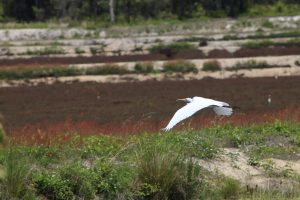
A Great Egret flying over the cranberry bogs. Photo by John Parke
The New Jersey Pinelands is classified as a United States Biosphere Reserve and in 1978 was established by Congress as the country’s first National Reserve. It includes portions of seven southern New Jersey counties, and encompasses over one-million acres of farms, forests and wetlands. The Pinelands sit atop the Kirkwood-Cohansey aquifer that contains approximately 17.7 trillion gallons of water, thanks in part to its cranberry farmers that maintain approximately 9 acres of healthy forested watershed for every acre that is planted in cranberry vines. These growers produce between 40 and 60 million pounds of cranberries a year.
“The original cranberry growers here in the pines bought up thousands of acres of land that had been seriously damaged by the charcoal and iron industries of the late 1700’s and early 1800’s. Through the generations we have continued to maintain the pines at our own expense while making a living by growing a native super fruit. We are extremely pleased to be able to continue this stewardship with help from NJ Audubon and NRCS,” said Joe Darlington of Joseph J. White, Inc.
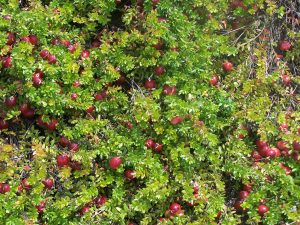
American Cranberry, photo by John Parke
Working Lands for Wildlife funding for Northern Bobwhite became available in NJ in 2017 and is specifically focused on conserving, restoring and enhancing Pine Savannah habitat. The focus on the Northern Bobwhite and Pine Savannah habitat was stimulated in part by a Bobwhite research project at another Ocean Spray Cooperative farmer-owner, Pine Island Cranberry Company of Chatsworth, New Jersey. The Pine Island project made headlines with the translocation of wild Northern Bobwhite from Georgia to the New Jersey Pinelands between 2015 and 2018. These radio-collared Bobwhites were tracked and studied to determine if wild Bobwhite from southern latitudes could support population recovery in the Mid-Atlantic region. The Northern Bobwhite Restoration Initiative, led by New Jersey Audubon in cooperation with Tall Timbers Research Station of Tallahassee Florida, the University of Delaware and New Jersey Division of Fish and Wildlife (NJDFW), will be presenting its findings from the translocation project this fall.
“We are incredibly proud of all the good work our farmer-owners do within their communities as stewards of the land,” said Christina Ferzli, Director of Global Corporate Affairs at Ocean Spray Cranberries. “At Ocean Spray, impact is not a part of our business, it is our business. Thanks to the dedication of farmers like Joseph J White, Inc and Pine Island Cranberry, Ocean Spray has committed to verifying 100% of its cranberry crop as sustainably grown by 2020.”
“It’s exciting to see the overwhelmingly positive response and enthusiasm for the Northern Bobwhite Restoration Initiative, especially from the farmers and landowners in the Pinelands region,” said John Parke, NJ Audubon Stewardship Project Director. “It’s especially great to see the active role that Ocean Spray producers in the New Jersey Pinelands are taking in this conservation effort. As the NJDFW’s Northern Bobwhite Action Plan indicates, ‘The Pinelands region probably represents the greatest potential growth area for wild bobwhite within their range in New Jersey.’“
For more information about NRCS Working Lands For Wildlife Program contact John Parke of NJA ([email protected]) or Austin Damminger of Quail Forever/NRCS ([email protected])




